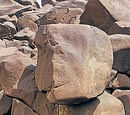
Bellary is changing the course of history. While the huge deposits of iron ore in Bellary are rewriting the political history and geography of the state, a chain of hills close to Bellary is adding to the interesting history and culture of human settlements in India.
About eight km from Bellary is the Sanganakallu complex of hills (also referred to as peacock hills) where archaeologists have discovered one of the earliest village settlements in South India. These settlements date from the Neolithic period (3000 BC – to the beginning of the Christian era).
The first settlers here are said to be the ones who established the first villages in South India. These settlers traded stone tools among the Neolithic people in that region. The region is considered the largest stone tool producing centre anywhere in South India.
Neolithic art on boulders
The Sanganakallu village settlement, spread over an area of 1,000 acres, is considered the largest village complex known so far. The rock art that can be seen on the boulders of the hill chain is evidence of rituals and social ceremonies involving ringing rocks, still preserved by way of hand-percussion marks.
Grinding grooves where stone axes were polished, shallow concave surfaces on boulders where grain was processed, and dykes where the dolerite was exploited to manufacture stone tools on a large scale bears testimony to the rich Neolithic culture and the skills of the people.
Earliest agriculturists
The people who settled at Sanganakallu were the earliest agriculturists who cultivated small millets and pulses. They kept cattle, and sheep and cattle domestication was prevalent in the area. They erected separate areas for dumping dung, including sheep and goat dung. These heaps have survived till today in the form of ash mounds. One can see them at Kupgal, Kudathini, etc. The people of Sanganakallu traded stone tools to the other Neolithic people in the wider Rayalaseema region. By about 2000 BC, this settlement was the largest stone tool producing centre anywhere in South India. The hill complex of Sanganakallu preserves the earliest houses of mud and stone, rock art evidence for rituals and social ceremonies. By 1500 BC, cemeteries were created to bury the dead. In fact different types of burial structures have been documented from these hills.
Archaeologist’s delight
Sanganakallu has been an archaeologist’s delight because of a high concentration of findings in a small area. In fact, archaelogists from the Karnatak University and Cambridge University have been working at this site since 1997. Over the years, they have carried out a series of multidisciplinary investigations. Many archaeologists from all over the country and abroad have worked in this area and the findings have been published in many leading journals devoted to archaeology.
Many publications are in progress including a 1,000 page scientific study. The entire area has been digitally mapped and every millimeter of the cultural landscape has been recorded on these maps.
Sanganakallu is not the only interesting archaeological site in Bellary. There are several more. But many of them are getting destroyed due to widespread quarrying and mining activities in Bellary. Luckily, for Sanganakallu and other sites, a museum similar to that in Hampi is coming up at the Kannada and Culture complex, adjacent to the Deputy Commissioner’s residence in Patel Nagar, Bellary. A fully built two-storied building (about 8000 sq ft) has been made available by the district administration for the museum. Many of the findings from the Sanganakallu site will be displayed at this museum.
The proposed museum complex aims to bring into focus the history and cultural heritage of Bellary and its environs. It aims to inculcate in the people a commitment to preserving their heritage with a deep sense of pride and concern. There are also plans to create an audio-visual time capsule of landmark of the people of the region through the ages.